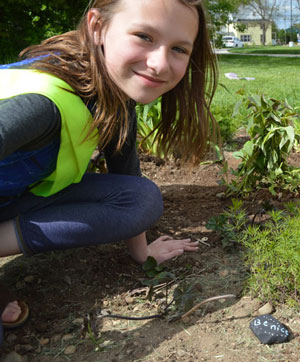It’s a small garden with the potential for enormous impact. And it’s all organic, so that means worms and manure. But don’t worry, says fifth-grader Sydney Dyess: While worms are as wiggly as you would expect, manure has nowhere near the nasal nastiness you might think.

“They take it to a place and clean it,” Sydney explained. “It actually smells kind of good, like fresh grass.”
Sydney is one of a handful of Central Elementary students who recently finished installing a pollinator garden aimed at attracting animals and insects that help transfer pollen for reproduction of many plant, fruit and vegetable species.
According to the U.S. Fish and Wildlife Service, more than 75 percent of the nation’s food crops rely on pollinators, whose populations are in decline. Not to mention their role in pollinating plants that animals, birds and insects rely on.
Conservation Club

The two dozen third- through sixth-graders are part of the school’s Conservation Club. The voluntary after-school group, now in its fourth year, is responsible for recycling paper, plastic and printer ink at the school.
They also fashioned recycled compost bins so classrooms could use discarded fruit peelings to study decomposition.
For the pollinator garden, students killed existing grass using a spray mixture made from cider vinegar and a bit of dish soap. Manure and sphagnum moss was added for fertilizer. Once the perennials had been planted, students painted rocks with the names of the plants so others will know what is growing.
The organic garden includes 13 perennials chosen by students after researching plants that most attract pollinators such asbees, butterflies, hummingbirds and ants. Plants include bee balm, anemone, butterfly weed, coreopsis and yarrow.

Parapro Laurie Lowry, who leads the club, said the pollinator garden fulfills a requirement of being designated by the state as a Green School, a designation Central has held for three years thanks to the Conservation Club.
“The thing I’ve seen evolve the most in the kids is that they have gained a great deal of awareness about how, in nature, everything is linked together, including them,” Lowry said.
CONNECT









